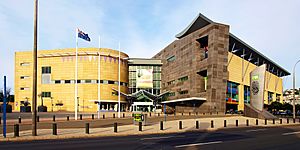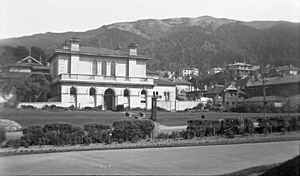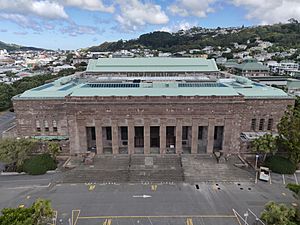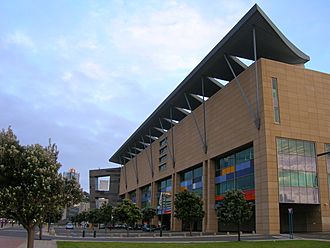Te Papa facts for kids
 |
|
| Former name | Dominion Museum and National Art Gallery |
|---|---|
| Established | 1992 |
| Location | Wellington, New Zealand |
| Visitors | 1.5 million (2017) |
The Museum of New Zealand Te Papa Tongarewa is New Zealand's national museum, located in Wellington. Usually known as Te Papa (Māori for "the treasure box"), it opened in 1998 after the merging of the National Museum of New Zealand and the National Art Gallery. The 17th-most-visited art gallery in the world, an average of more than 1.5 million people visit every year.
Te Papa Tongarewa translates literally to "container of treasures" or in full "container of treasured things and people that spring from mother Earth here in New Zealand". Te Papa's philosophy emphasises the living face behind its cultural treasures, many of which retain deep ancestral links to the indigenous Māori people. The Museum recognises the partnership that was created by the signing of the Treaty of Waitangi, te Tiriti o Waitangi, in 1840.
WELT is the Index Herbariorum code for Te Papa.
Contents
History
Colonial Museum
The first predecessor to Te Papa was the Colonial Museum, founded in 1865, with Sir James Hector as founding director. The Museum was built on Museum Street, roughly in the location of the present day Defence House Office Building.
The museum prioritised scientific collections but also acquired a range of other items, often by donation. These included prints and paintings, ethnographic curiosities, and items of antiquity.
In 1907, the Colonial Museum was renamed the Dominion Museum and took on a broader focus. The idea of developing a public art gallery in Wellington was gathering support, and the Science and Art Act of 1913 paved the way for a national art gallery in the same building.
Dominion Museum
In 1936, a new building to house the Dominion Museum and newly formed National Art Gallery of New Zealand opened in Buckle Street as a part of the newly built National War Memorial. It incorporated the New Zealand Academy of Fine Arts, which sold its land and donated the proceeds to the new organisation.
National Art Gallery
The National Art Gallery was opened in 1936 and occupied the first floor of the National Art Gallery and Dominion Museum building on Buckle Street, Wellington. It was originally populated with a collection donated by Academy of Fine Arts. The Gallery was formed with the passing of the National Art Gallery and Dominion Museum Act in 1930.
Both the Dominion Museum and Gallery were overseen by a single board of trustees. The official opening was by the Governor General in 1934.
The early holding consisted largely of donations and bequests, including those from Harold Beauchamp, T. Lindsay Buick, Archdeacon Smythe, N. Chevalier, J. C. Richmond, William Swainson, Bishop Monrad, John Ilott and Rex Nan Kivell.
Eru D. Gore was secretary-manager from 1936 until his death in 1948 when Stewart Maclennan was appointed the first director. This was the first appointment in New Zealand of a full-time art gallery director. Past directors of the gallery include:
- Stewart Maclennan (1948–68)
- Melvin Day (1968–78)
- Luit Bieringa (1979–89)
- Jenny Harper (1990–92)
Te Papa
Te Papa was established in 1992 by the Museum of New Zealand Te Papa Tongarewa Act 1992. Part of the remit for Te Papa was to explore the national identity of New Zealand.
The official opening took place on 14 February 1998, in a ceremony led by Prime Minister Jenny Shipley, Sir Peter Blake, and two children. The first chief executive of the Museum was Cheryll Sotheran. Māori traditional instrumentalist Richard Nunns co-led the musicians at a dawn ceremony on opening day.
The museum is run by a board appointed by the Minister for Arts, Culture and Heritage. Board members have included: Wira Gardiner, Fiona Campbell, Sue Piper, Judith Tizard, John Judge, Miria Pomare, Michael Bassett, Christopher Parkin, Sandra Lee, Ngātata Love, Ron Trotter, Glenys Coughlan, Judith Binney, Philip Carter, and Wendy Lai.
The museum had one million visitors in the first five months of operation, and between 1 and 1.3 million visits have been made in each subsequent year. In 2004, more space was devoted to exhibiting works from the New Zealand art collection in a long-term exhibition called Toi Te Papa: Art of the Nation. Filmmakers Gaylene Preston and Anna Cottrell documented the development of Te Papa in their film Getting to Our Place.
CEOs of Te Papa include:
- Cheryll Sotheran (1992–2002)
- Seddon Bennington (2003 – July 2009)
- Michael Houlihan (Aug 2010 – May 2014)
- Rick Ellis (Nov 2014 – May 2017)
- Geraint Martin (May 2017 – 2019)
- Courtney Johnston (2019–present)
The museum has sometimes been the centre of controversy. The siting of significant collections at the water's edge on reclaimed land next to one of the world's most active faults has resulted in concern by some people. There has been criticism of the "sideshow" nature of some exhibits, primarily the Time Warp section, which has closed. There has also been criticism that some exhibits were not given due reverence. For example, a major work by Colin McCahon was at one stage juxtaposed with a 1950s refrigerator in a New Zealand culture exhibition.
The Maori name of the museum has caused controversy. In 1989 the Maori iwi Te Āti Awa, located near Wellington, requested that the Ngāti Whakaue iwi grant a name to the museum, which resulted in the Ngāti Whakaue bestowing the name Kuru Tongarerewa, an ancient ceremonial name important to the iwi evoking spiritual, historical, and cultural importance. However, the name eventually adopted by the museum caused offense by being a modification in the form of Te Papa Tongerewa. Meetings between the museum's board and the Ngāti Whakaue led to promises that the name would be changed to Te Papa Kuru Tongererewa, however the change did not occur.
New Zealand art commentator Hamish Keith has been a consistent critic of Te Papa at different times referring to it as a "theme park", the "cultural equivalent to a fast-food outlet" and "not even a de facto national gallery", but seemed to moderate his opinion later when making a case for exhibition space on the Auckland waterfront.
Staff restructuring at Te Papa since 2012 has generated significant controversy. In October 2018, Te Papa management promised to review restructuring plans, indicating that plans would be scaled back. In February 2019, the Collection Manager of Fishes Andrew Stewart and the Collection Manager of Molluscs Bruce Marshall were made redundant. Numerous museum experts and scientists in New Zealand and worldwide criticised the move, with researchers including Steve O'Shea advocating a boycott. In March 2019, the redundancies were delayed. In April 2019, the Museum reversed the decision for Andrew Stewart, offering him an alternative job. Between April and May 2019, Te Papa advertised a research position for a molluscan curator and awarded the job to an alternative candidate to Bruce Marshall. The advertisement and decision to not offer the job to Bruce Marshall was criticised harshly by outside experts, prompting moa expert Trevor Worthy to end his 30-year research association with the museum in protest.
On 23 June 2021, Te Papa Museum closed for two days for deep cleaning after an Australian tourist who visited the museum and its Surrealist Arts Masterpieces exhibit on 19 June tested positive for the SARS-CoV-2 Delta variant. In addition, 2,500 people who visited the museum around the same time were asked to go into self-isolation for between five and 14 days, depending on the part of the Museum they were visiting.
Current building
The main Te Papa building is built on former Wellington Harbour Board land, on the waterfront in Wellington, on Cable Street. The building contains six floors of exhibitions, cafés and gift shops dedicated to New Zealand's culture, history and environment. The museum also incorporates outdoor areas with artificial caves, native bushes and wetlands. A second building on Tory Street is a scientific research facility and storage area, and is not open to the public.
Te Papa was designed by Jasmax Architects and built by Fletcher Construction. The 36,000-square-metre (390,000 sq ft) building had cost NZ$300 million by its opening in 1998. Earthquake strengthening of the Cable Street building was achieved through the New Zealand-developed technology of base isolation, essentially seating the entire building on supports made from lead, steel and rubber that dampen the effect of an earthquake.
The site was previously occupied by a modern five-storey hotel. This was jacked off its foundations onto numerous rail bogies and transported 200 metres (660 ft) down and across the road to a new site, where it is now the Museum Hotel.
Collections
The History Collection includes many dresses and textiles, the oldest of which date back to the sixteenth century. The History Collection also includes the New Zealand Post Archive with around 20,000 stamps and related objects, and the Pacific Collection with about 13,000 historic and contemporary items from the Pacific Islands.
There are significant collections of fossils and archaeozoology; a herbarium of about 250,000 dried specimen; a collection of about 70,000 specimen of New Zealand birds; significant amphibians, reptiles and mammals.
The museum has the world's largest specimen of the rare colossal squid (Mesonychoteuthis hamiltoni). It weighs 495 kilograms (1,091 lb) and is 4.2 metres (14 ft) long. The squid arrived at the museum in March 2007 after being captured by New Zealand fisherman in the Ross Sea off Antarctica. The cultural collections include collections on photography, Māori taonga (cultural treasures), and Pacific cultures.
The Museum of New Zealand is also home to the Elgar Collection a valuable collection of English and French furniture and paintings the oldest of which date back to the seventeenth century. In 1946 the Dominion Museum one of Te Papa's predecessors received a bequest of some Fernside Homestead’s finest antiques from Ella Elgar’s will. Until 1992 these antiques were displayed in period rooms at the Museum but today objects from the Elgar Collection can be seen in many exhibitions at the museum.
Archives
The Archives are located in a separate building on 169 Tory Street and are open for researchers on appointment. There are two categories of archive collections: the museum archive and the collected archives.
The Museum Archive goes back to the founding of the Colonial Museum in 1865 and that comprise the archives of James Hector. The archives of the National Art Gallery of New Zealand are also part of these archives. The Collected Archives fall into two groups:
- Art-related records and other archival papers in specialist areas; for instance the archives of Toss Woollaston, Lois White and Leonard Mitchell)
- A wide variety of archival material, that include the diary of Felton Mathew, Surveyor General at the time of the signing of the Treaty of Waitangi, and battle plans and correspondences related to World War I; for instance the Gallipoli diary of Captain E.P. Cox.
Exhibitions
Te Papa has a mixture of long term exhibitions of cultural objects, hands-on and interactive exhibitions, cultural spaces and touring exhibitions. The long term exhibitions of cultural objects focus on New Zealand history, Māori culture and New Zealand's natural world. The hands-on and interactive exhibitions focus on engaging particularly young visitors and include both indoor areas and out-door areas built and planted for the purpose. The key cultural space is the Te Hono ki Hawaiki marae with very impressive whakairo.
All permanent exhibitions are free. Many of the touring exhibition are ticketed, but there are occasional free days.
In 2018, the Mountains to Sea and Awesome Forces exhibits were closed, with Te Taiao Nature taking their place. This new exhibit opened on 11 May 2019, with a 1,400 square-metre exhibition focussing on New Zealand's natural environment. The exhibition retains several features of the old exhibits, such as an earthquake simulation and a 495 kilogram (1,091 lb) Colossal squid.
A full list of exhibitions can be found here.
Library
Te Aka Matua Library, previously a publicly accessible library, is now open only to researchers by appointment between 10am-5pm, Monday-Friday. The library is a major research and reference resource, with particular strengths in New Zealand, Māori, natural history, art, photography and museum studies. It is located on the fourth floor of the main building.
Mahuki Innovation Accelerator
Mahuki is Te Papa's innovation accelerator. It is an in-residence programme in which 10 teams develop solutions to challenges facing cultural institutions.
See also
 In Spanish: Museo de Nueva Zelanda Te Papa Tongarewa para niños
In Spanish: Museo de Nueva Zelanda Te Papa Tongarewa para niños





